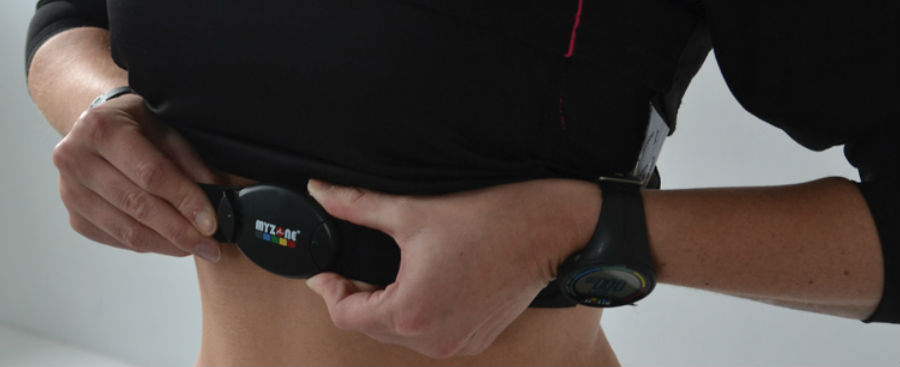 By Dr. Ayla Donlin, Special AFS Contributor
By Dr. Ayla Donlin, Special AFS Contributor
It can be challenging to keep heart rate training terms straight - from resting heart rate to recovery heart rate, from submaximal heart rate to maximal heart rate. This blog post will provide a brief explanation of some of the most common heart rate training terms and will explain how to use a heart rate monitor to measure each aspect.
In addition, this blog will share some insight into how to make the most of moments of your day when you are not participating in purposeful physical activity (and maybe not wearing your heart rate monitor).
Heart Rate Terms Defined
Resting Heart Rate: Heart rate (in beats per minute) at complete rest.
Recovery Heart Rate: How quickly or how much heart rate comes down (in beats per minute or percentage points) from an elevated intensity (can be within a workout or at the end of a workout).
Ambient Heart Rate: Heart rate at rest during the day. Ambient heart rate differs from resting heart rate in that it should be assessed when you have been awake for a while and are in a seated position (whereas resting heart rate should be assessed during sleep or right when you wake up and when lying down).
Submaximal Heart Rate: Heart rate throughout various intensities between resting and maximal heart rate. Moderate submaximal intensity ranges from 50-75% of maximum heart rate, whereas vigorous submaximal intensity ranges from 75-99% of maximum heart rate.
Maximum Heart Rate: The highest heart rate (in beats per minute) your system is capable of producing during exercise.
Measurement of Heart Rate
Resting Heart Rate: To obtain a true resting heart rate, wear your heart rate monitor overnight while you are sleeping. If you are not able to wear your monitor overnight, put it on right away in the morning and wear it for 5 to 10 minutes while you are still in bed. A decrease in resting heart rate is an indication of improved cardiorespiratory fitness – your heart has gotten stronger and can pump more blood with each beat and your vascular system has become more proficient.
Recovery Heart Rate: You can measure heart rate recovery or recovery heart rate in multiple ways – within a workout or at the end of a workout. Within a workout, take your heart rate up to 80% of your maximum heart rate (MHR) and hold it there for a minute or two, then decrease your workload significantly and see how much your heart rate recovers within one minute. Repeat this several times. An example of this would be running on the treadmill at a speed and incline that challenged your heart rate to 80% MHR and then decreasing the speed and incline to a light walk and measuring how much your heart rate recovers within a minute.
At the end of your workout, measure how much your heart rate comes down once you have stopped exercising (you are just sitting or standing) – measure how much your heart rate decreases within one minute (in beats per minute).
You can perform these assessments every 4 to 8 weeks to monitor improvements. Eventually, your recovery should level out as you become more and more fit.
Ambient Heart Rate: Wear your heart rate monitor during the day when you are in a seated position to measure ambient heart rate. Examine the difference between your ambient heart rate and your resting heart rate (ambient should be higher).
A decrease in your ambient heart rate over time could indicate an improvement in cardiorespiratory fitness. However, if you choose to monitor your ambient heart rate to assess changes, keep in mind that there are many factors which affect heart rate and try to keep as many factors consistent as possible (i.e. time of day, pre or post-exercise, food or caffeine consumption, etc.).
Submaximal Heart Rate: Wear your heart rate monitor and measure how your heart rate responds to various workloads (i.e. speed, resistance, incline, etc.). Examine which workloads are necessary to take you from moderate (50-75% MHR) to vigorous intensity (75%+ MHR). As you become more fit, more of a workload should be required to elevate your heart rate into vigorous submaximal intensities.
Recent research indicates that even if we meet the recommended guidelines for physical activity but spend the majority of our day in sedentary behaviors (seated, non-mobile), we are still at increased risk for chronic disease and associated issues.
Maximum Heart Rate: In order to get an absolute maximum heart rate, you would need to perform a maximal assessment, such as a graded exercise test, and we recommend doing that only under the supervision of qualified health professionals. You can ask your physician about a graded exercise test.
Have some fun measuring these aspects of heart rate training!
Beyond the Measurements – Exploring NEAT
Beyond purposeful exercise, our general activity throughout the day is also important for weight management and health purposes. In fact, recent research indicates that even if we meet the recommended guidelines for physical activity but spend the majority of our day in sedentary behaviors (seated, non-mobile), we are still at increased risk for chronic disease and associated issues. Here’s the good news - we can implement small changes throughout our day to avoid long periods of sedentary behavior.
NEAT or non-exercise activity thermogenesis refers to the metabolic activity of your body during non-exercise portions of your day (which for most of us, comprises the majority of our day). You can significantly elevate your daily caloric expenditure by making small adjustments to your lifestyle (for example, choosing the stairs rather than the elevator).
Increase your NEAT by incorporating periods of standing or moving between periods of sitting. A general recommendation is to get up and move for two to three minutes every 30 minutes or so. This will increase the metabolic activity of your body (primarily by engaging your large muscle groups), and cause you to burn more calories than you would if you stayed seated.
In fact, as you finish this blog post, now is a great time to stand up and stretch or take a short walk!
Find out more about MYZONE and their special 2 months of FREE licensing for AFS members!
Related Post: How Heart Rate can be Leveraged into Gaining Meaningful Insight into your Client
Dr. Ayla Donlin is the director of the LifeFit Center @ The Beach, a health and fitness facility and educational laboratory on the campus of Long Beach State University (LBSU). Ayla’s passions are fitness, education, and well-being, and as a result, she holds multiple positions within higher education and the fitness industry.
Ayla is a lecturer in the kinesiology department at LBSU and has been teaching courses since 2008 in the fitness and sport studies options. She is also the chair of the Exercise is Medicine on Campus (EIMOC) Leadership Team at LBSU and advises the EIMOC student organization.
Ayla has been active in the fitness industry for over 12 years as a group fitness instructor, personal trainer, group fitness director, master trainer, and health club general manager. She is currently an American College of Sports Medicine (ACSM) certified personal trainer and an Exercise is Medicine® credentialed fitness professional.
Ayla also serves as a consultant within the fitness industry. She has been working with Johnny G. since 2007 as a Master Instructor for Krankcycle® and became a Master Instructor for IN-TRINITY® in 2015. Ayla is also a Master Trainer for MYZONE®, a wearable physical activity tracker that rewards effort. She creates educational content for the MYZONE® blog, Podcast, and learning management system.
As a passion and hobby, Ayla has organized, led, and participated in over 100 hours of Spin-a-thon/Krank-a-thon fundraisers benefitting various organizations like the Challenged Athletes Foundation.


Join the Conversation!